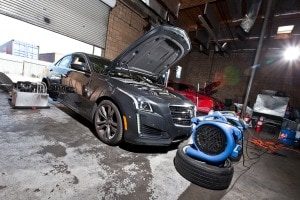Are you in the market for a new or used vehicle and having difficulty finding something in your budget? Or are you finding yourself making trade-offs to find something you can afford (i.e. less cargo space, lower trim level). A reporter from a national news publication would like to speak with you about your experience; please reach out to PR@Edmunds.com by this Friday, 11/21 for details.
2014 Cadillac CTS Vsport and 2014 Cadillac XTS Vsport: Dyno Tested
 Edmunds.com
Member, Administrator, Moderator Posts: 10,316
Edmunds.com
Member, Administrator, Moderator Posts: 10,316
 2014 Cadillac CTS Vsport and 2014 Cadillac XTS Vsport: Dyno Tested
2014 Cadillac CTS Vsport and 2014 Cadillac XTS Vsport: Dyno Tested
Edmunds.com dyno-tests the 2014 Cadillac CTS Vsport and 2014 Cadillac XTS Vsport.
Tagged:
0

Comments
You are referencing intake air charge temps after intercooling? That's interesting, I wonder if there's a flow imbalance in the intercooler coolant circuit? For sure a transverse layout doesn't help, it already causes difficulties with air intake and exhaust routing.
Are those two lines leading into the coolant bottle coming from the intercooler circuits?
I think a lot of us miss his comments.
As far as this goes, I always appreciate Jay's analysis; I just think the music is too much and annoying. I just want to hear the car and Jay speak.
How come my vehicle still pulls a ~13.0-13.3 quarter mile at 108mph - besting this 15 year newer (since the m5 launched) CTS with more HP, a bit lower weight, alot more torque, and all sorts of technology.
That's my biggest concern with this car - it's not pulling the quarter mile I would hope to see from this level of power.
2) Gearing. I would be interested in comparing the mpg of these two cars. Buyers of an M5 in 2001 probably didn't give their buttlers bum about gas mileage. Nowadays mpg is the "#1" most important factor to consumers (despite the fact that they all rush out and buy the less fuel efficient CUV version of a car instead of the sedan/hatch).
First, easier questions. Joefrompa - your M5 puts down about 360-365 whp on my dyno, so the power differential isn't that large. Nor is the weight (less than 100 lbs). Given that the CTS Vsport is turning in similar ETs with higher traps (12.9-13.1@108-110 except Edmunds), I'd say its down to traction and gearing as the M5 wears the same size rear tires as the Vsport. And don't forget that at full throttle accel with redline shifts, the engine doesn't spend any time below 4000 rpm where much of that torque advantage is. You also have to make sure the intercoolers are cooled down or else you'll lose power.
On the topic of temperatures, yes, we were able to log temps at the inlet, as well as at each cylinder bank after the intercoolers. On the CTS, they were pretty consistent side to side. But on the XTS we saw a larger differential (20 F). The rear bank was consistently hotter AFAICT.
In terms of boost levels, the XTS went up to about 8 psi, dropped down to 7 psi till 4000 rpm or so, and then slowly climbed to 11-12 psi of relative boost pressure at redline. By comparison, the CTS came right up to 12 psi and held it all the way across. As JK mentioned, there was a lot more knock on the XTS and this is the primary reason for the torque hole on that car. We even tried adding a little octane to the equation and it made very little difference, but where it did help was that dip. So on 93 octane it will probably look better.
Both cars were in full on torque control mode on the dyno. You could see on successive runs that the cars were learning the engine response on the dyno and dialing back the midrange torque to hit the torque targets. And even when we cooled things down, power didn't change much at all. So, I don't think we'll see a big difference in peak numbers on 93 octane without retuning.
In dissecting the ECU programming, there are specific torque target tables, and the ECU is empowered to do many things to get to those levels, including throttle reduction, boost reduction and timing reduction. We saw the throttle drop close to 50% right after spoolup in some cases which is where the little drop off in torque comes from. But later runs showed less torque here as the ECU learned and was more predictive. This would be less prevalent on the road because the load on the dyno is somewhat higher especially at low rpms, causing the boost response to be more aggressive.
The ECU is arguably the most complex spark ignition ECU that GM has ever used. Not only do we have target torque tables, but the torque models includes things like turbocharger compressor efficiency, predicted turbocharger turbine speeds, and many other variables. I can't wait to start tuning them as based upon the way ECU is limiting the output in stock form, this engine will easily pump out 500+ lbs-ft of torque and 460-480 hp with minimal mods/tuning and should come close to matching the old CTS-V acceleration wise when doing so (I own a 2010 CTS-V 6MT myself). And as JK said, what does this tell us about the next CTS-V? Can't wait.